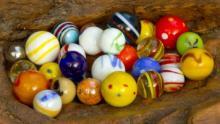
Marbles are small perfectly round objects that have been played with by children down through the ages. There is evidence of marble games being played by the ancient Egyptians, Aztecs, Romans, and Greeks. Although some early games may have been played with stones and nuts, there have also been small clay balls found in many prehistoric ruins.1
Marble Materials
Marbles have been made of round stones, clay, marble, porcelain, glass, and steel. They became known as marbles when white alabaster marble was the popular stone used to make them. The Germans dominated the market in producing handmade marbles from the mid-1800s until the end of the nineteenth century, when several American entrepreneurs began to develop techniques for producing machine-made marbles of glass. Glass was melted with color added to produce brightly colored solid marbles or swirled into the glass to produce corkscrews and different designs. Some picture marbles were produced that had decals of popular comic-strip characters. There is a vast array of designs and logos used in making marbles with many artists and glass companies producing fine art marbles.2
Marbles have become very collectible over the years. Rare marbles can be marbles made from pure, ground marble or other desirable stones. Also, inexpensive clay marbles, which were once the most common marbles available, are also now high in demand because they are hard to find. Vintage handmade marbles that were produced individually during the last half of the nineteenth century are also very collectible.3
There is a variety of types of marbles, often named after the material from which they are made and the designs put into them. An alley is a marble made from alabaster or marble that is streaked with wavy or other patterns with such exotic names as corkscrew, spiral, snake, ribbon, onyx, swirl, bumblebee, cat’s eye, and butterfly. An aggie is made of agate or glass that resembles agate with various patterns like the alley. Steelies are made of steel.4
Marble Games
There are many marble games played, and rules may vary from region to region. To play a game of marbles a circle, which is often ten foot in diameter, is drawn on the ground. To determine who starts play each player lags with his shooter marble, also called a taw, to see who comes closest to a predetermined line. In lagging, a child may toss his shooter or knuckle down to shoot it. Knuckling down is a technique in shooting the marble with the thumb while the knuckles are on the ground. Usually players must put a number of their own marbles within the circle. The objects of the various games often include hitting other players’ marbles and keeping them. Names of some of the popular games are ring taw, boss out, cherry pit, bridgeboard, bun-hole, hundreds, and nine holes.5
Although the game of marbles has faded in popularity in recent years, there are still several serious marble tournaments played throughout the world. The British World Marbles Championship has been held every year in England since at least the 1600s, with teams participating from other countries. The National Marble Tournament is held every year in Wildwood, New Jersey, which is open for boys and girls under the age of 14. Participants in this national tournament must first compete in a local tournament to qualify.6
- 1. “History of Marbles.” iMarbles.com. < http://imarbles.com/historyofmarbles.php > 3 Dec. 2010.
- 2. Ibid.
- 3. “Marble History.” CentralConnector.com. < http://www.centralconnector.com/GAMES/marbhist.html > 3 Dec. 2010.
- 4. “Marble (toy).” Wikipedia. < http://en.wikipedia.org/wiki/Marble_(toy) > 3 Dec. 2010.
- 5. “How to Play Marbles.” LandofMarbles.com. < http://www.landofmarbles.com/marbles-play.html > 3 Dec. 2010.
- 6. “Marbles.” Streetplay.com. < http://www.streetplay.com/thegames/marbles/ > 3 Dec. 2010.

